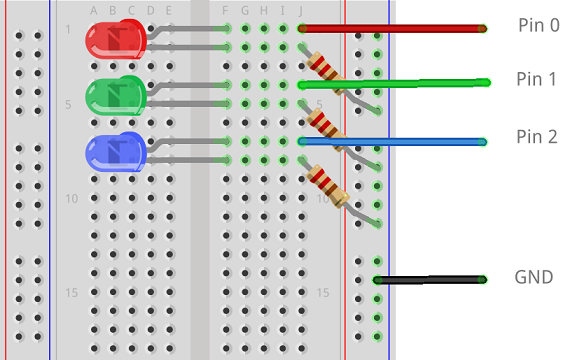BBC micro:bit
LEDs With MicroPython
Introduction
You can use the external pins to connect more LEDs and have colours other than red. Using some LEDs gives us a chance to use the 3 main large pins as digital and analogue outputs.
This project uses 3 LEDs. Each LED will need a resistor. Here I've used 220 Ohm resistors, one for each of the LEDs used.
Making The Circuit
The longer legs of the LEDs are the anodes or positive legs. These are the ones we connect to the micro:bit pins. The shorter legs are the cathodes, negative. They get connected to GND through a resistor.

Programming - Digital
We can turn the LEDs off by using the write_digital() method and supplying either a 1 (HIGH) or 0 (LOW) in the brackets to specify what we want to do.
This program blinks each of the LEDs in turn.
from microbit import *
pin0.write_digital(0)
pin1.write_digital(0)
pin2.write_digital(0)
sleep(1000)
while True:
pin0.write_digital(1)
sleep(500)
pin0.write_digital(0)
pin1.write_digital(1)
sleep(500)
pin1.write_digital(0)
pin2.write_digital(1)
sleep(500)
pin2.write_digital(0)
Programming - Analog
We use the write_analog() with a value from 0 to 1023. This creates a PWM signal (pulse width modulation) on the pin that makes the LEDs fade in and out very slowly.
from microbit import *
pin0.write_digital(0)
pin1.write_digital(0)
pin2.write_digital(0)
sleep(1000)
while True:
for i in range(0,1024):
pin0.write_analog(i)
pin1.write_analog(i)
pin2.write_analog(i)
sleep(10)
for i in range(1023,-1,-1):
pin0.write_analog(i)
pin1.write_analog(i)
pin2.write_analog(i)
sleep(10)
Challenge
Using 3 LEDs, you can count up to 7 in binary. The following table shows you how we can represent these using 3 bits (3 binary place values).
| Denary | Binary |
|---|---|
| 0 | 000 |
| 1 | 001 |
| 2 | 010 |
| 3 | 011 |
| 4 | 100 |
| 5 | 101 |
| 6 | 110 |
| 7 | 111 |
The following pseudocode will give you a one or zero in the variables fours, twos and units. Your leftmost LED is the fours LED, then twos, then units.
denary ← any integer from 0 to 7 included
fours ← denary // 4
remainder ← denary % 4
twos ← remainder // 2
units ← remainder % 2

